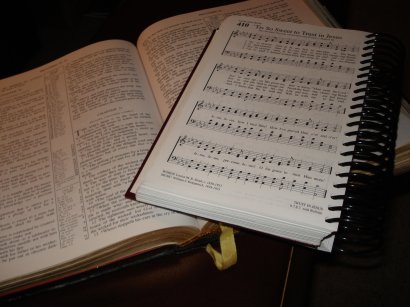
Home
Statement of Faith
Origin of Music
Purpose of Music
Uses of Music in the Church
Uses of Music Personally
The Church Music Ministry
About me
Creating the Congregational Part of the Service
Congregational hymns in many churches have little meaning. This is due to several factors. First, many Christians do not realize the importance of congregational music. Another reason is that these Christians grow bored with the music. This happens because the same Christians do not pay attention to what they are singing but it can also happen because song leaders use the same songs over and over.
The purpose in the congregational part of the service is to prepare the congregation for the sermon. Every hymn that is sung should affect each person spiritually, emotionally, and physically to be receptive to God's message for that service. Below are several tips and ideas to help accomplish this. I have also included my reasoning from more than thirty years of experience. However, I am not suggesting that my way is the only way. There is no clear Biblical direction on these suggestions.
1. The first congregational song of a service is the most critical. This song has the capability of making preaching easier for the pastor or more difficult. The first song should be the quickest and most vibrant song of the entire service. This song creates an attitude of excitement and engages the congregation in the service. A slow song as the first will begin to put the congregation to sleep, making it very difficult for the pastor to engage the congregation. I have seen it happen many times. Imagine starting a service with Amazing Grace. While it is a fantastic song, it does not belong as the beginning congregational.
This song should also be in a major key. Minor keys have the affect of quieting and muting any excitement in the service. A great contrast of this is in Christmas songs. Starting a service with Joy to the World (a major key) would be great. Starting service with We Three Kings (a minor key) could have harmful affects on the service.
2. The congregational song right before the sermon is the second most critical of the service. This is the final opportunity for everyone to become engaged in the service before the sermon. Generally, the middle of the service is more sedate with things like slower congregational hymns and announcements. This last song has the potential to re-energize the congregation so they are paying attention to the sermon. So, like the first song, the last song must be a peppy song in a major key.3. When in front of the congregation, the song leader must talk with excitement and enthusiasm, even if he does not feel that way. A song leader's attitude can affect how a song is sung and the mood of the congregation, so personal feelings must be left off the platform.
4. The music directing (waving of the arms) by the song leader is not for the congregation's benefit. Directing is to keep him and the instrumentalists together, providing a solid basis for the song. This, in turn, will make the congregation feel more secure and they will sing out more.
5. New songs for the congregation should be taught in the least formal service, generally the mid-week service. One way to do this is to have the choir learn the song first and then sing it with the congregation when the song is being taught. This can also be done without a choir but the song leader must know the song extremely well.
Contact Us